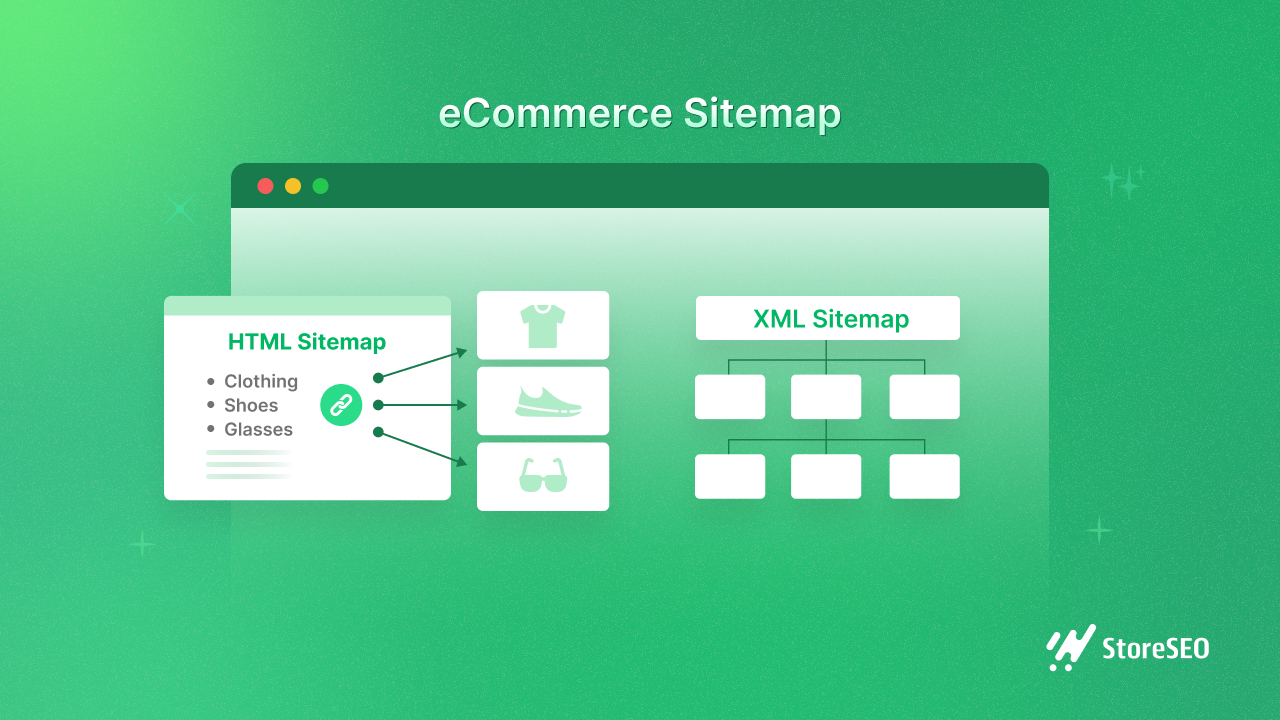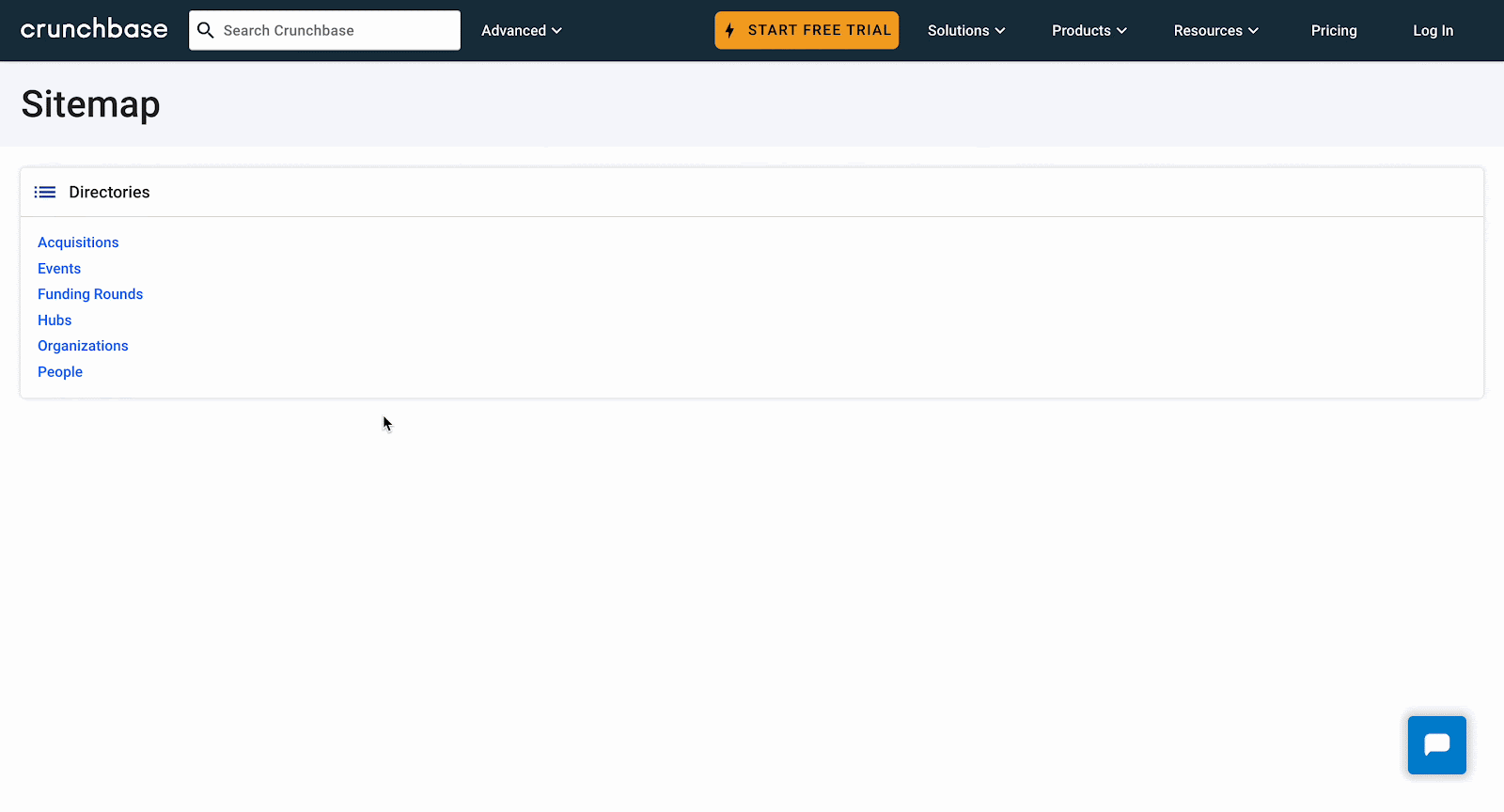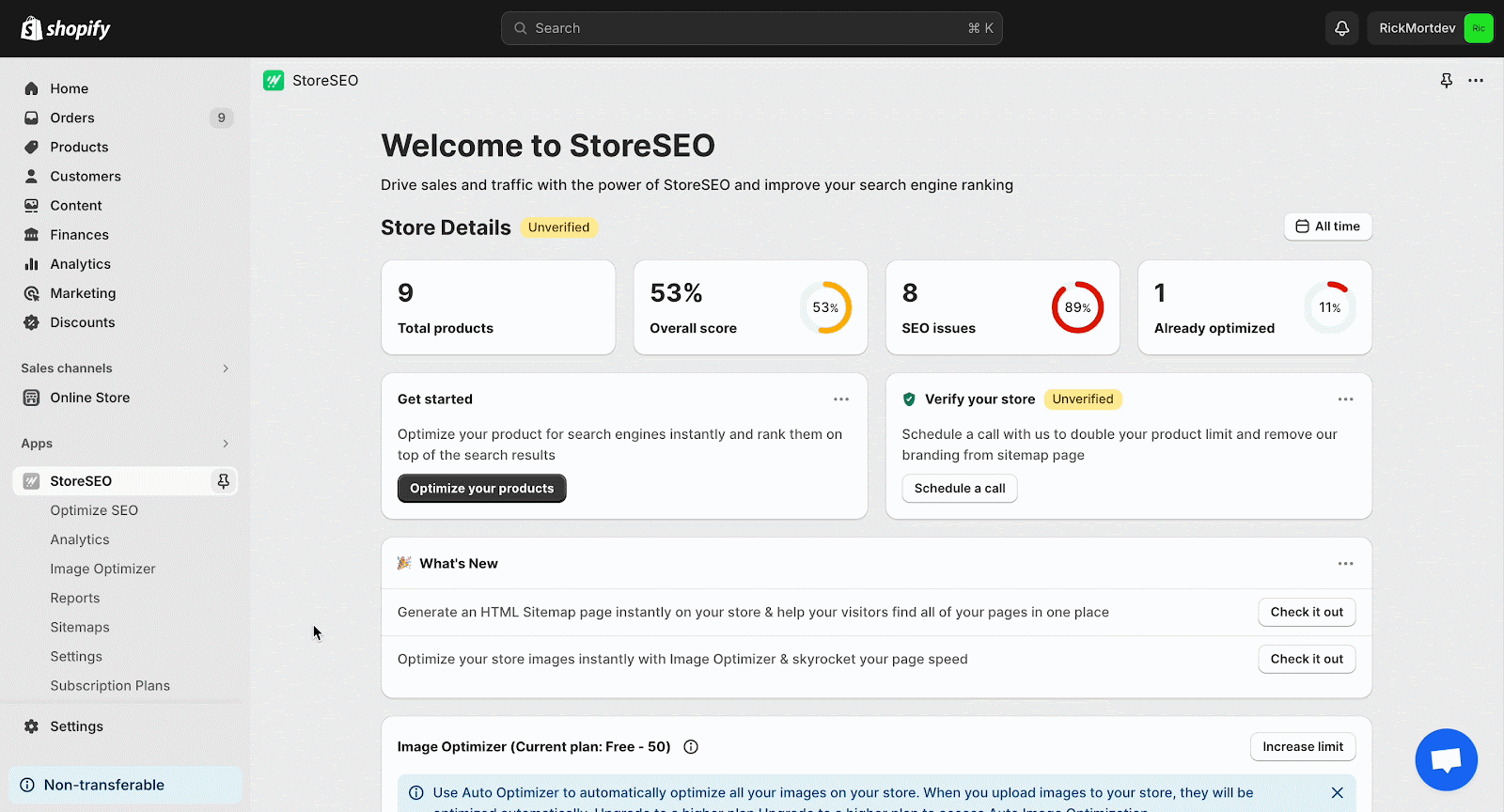の 電子商取引サイトマップ サイトマップは、ストアのクロール可能性とインデックス作成を改善し、オーガニック トラフィックをもたらすのに役立ちます。大規模な e コマース ストアをお持ちの場合、サイトマップは SEO ゲームで成功するための究極の鍵となります。このブログでは、e コマース サイトマップの詳細について説明します。それでは、さっそく始めましょう。

電子商取引サイトマップとは何ですか?
電子商取引サイトマップとは、電子商取引ストアのマップのことです。検索エンジンのクローラーが Web ページを見つけて理解するのに役立ちます。基本的には、ストアで利用できるさまざまなページ、カテゴリ、製品をすべて含む Web サイトの構造です。そのため、検索エンジンのクローラーは、このマップを通じてすべてのページを簡単に見つけることができます。
電子商取引ストアのサイトマップの種類
サイトマップは主に、XML サイトマップと HTML サイトマップの 2 種類に分類されます。以下では、これらのサイトマップについて詳しく説明します。
XML サイトマップ
の XML サイトマップ 検索クローラーがすべての Web ページを見つけて理解するためのマップです。Web サイトのすべてのページ URL のリストが構造化されて含まれています。
HTML サイトマップ
の HTML サイトマップ ウェブサイト訪問者向けに特別に設計されています。ウェブサイトのすべてのページを 1 か所で見つけるのに役立ちます。
XML VS. HTML 電子商取引サイトマップ
| 比較のポイント | XML 電子商取引サイトマップ | HTML 電子商取引サイトマップ |
| 目的 | 検索エンジン向けに設計 | 人間のために設計 |
| コンテンツ | Web ページに関するメタデータ (重要性、更新頻度、サイト内の他の URL との関係など)。 | リンクを階層的かつカテゴリ別に整理することで、ユーザーフレンドリーなナビゲーションエクスペリエンスを提供することに重点を置きます。 |
| 使用事例 | さまざまな検索エンジンのインデックス作成プロセスに役立ち、検索結果における Web サイトの可視性が向上します。 | 訪問者が単一のページから特定のページや製品を素早く見つけられる、ユーザーフレンドリーなマップとして機能します。 |
電子商取引ストアで使用されるその他の種類のサイトマップ
これまで、主な 2 種類のサイトマップについて説明してきました。ただし、これらに加えて、e コマース ストアでよく使用される 3 種類のサイトマップがあります。以下で、これらのサイトマップについてさらに詳しく見ていきましょう。
TXT(テキスト) サイトマップ
TXT (テキスト) サイトマップは、すべてのページ URL のリストがプレーン テキスト形式で含まれている単純なテキスト ファイルです。XML サイトマップとは異なり、TXT サイトマップは検索エンジン クローラーにそれほど詳細な情報を提供しません。
画像サイトマップ
画像サイトマップは、検索エンジンが Web サイトの画像をクロールするのに役立つ別の種類の XML サイトマップです。画像サイトマップには、クローラーが Web サイトを理解するのに役立つ特定の画像を識別する HTML タグが含まれています。
ビデオサイトマップ
の ビデオサイトマップ ウェブサイトでホストするビデオに関する追加情報を提供します。ビデオのタイトル、説明、再生時間、サムネイル画像などの追加情報を提供することで、検索エンジンのクローラーがウェブサイトのビデオ コンテンツを理解し、見つけるのに役立ちます。
電子商取引に最適なサイトマップの形式は何ですか?
さまざまな種類のサイトマップの中で、eコマース Web サイトには XML サイトマップが最適です。大規模な eコマース Web サイトの場合、XML サイトマップを使用すると、検索エンジンのクローラーがすべてのページを簡単に見つけられるようになります。
さらに、HTML サイトマップは、e コマース ストアにとって素晴らしい追加機能です。ストアに多数のカテゴリとページがある場合、HTML サイトマップを使用すると、すべてのページとカテゴリを 1 か所にまとめることができます。これにより、訪問者は探している特定のページを簡単に見つけることができます。
電子商取引サイトマップに含まれるもの
eコマースサイトマップには、ウェブサイトに関する情報が構造化されて含まれています。ウェブサイトのURLが…タグ。これは、Web サイトの URL の親タグであり、子タグを通じてさらに情報を追加できます。
電子商取引サイトマップでは、タグは正規URLを指定するために使用されます。また、タグにはページ変更の情報が含まれます。同様に、次のようなタグも使用できます。そして各ページの優先度と更新頻度を指定して、検索エンジンがページをより適切に理解できるようにします。次の XML 電子商取引サイトマップの例を参照してください。

サイトマップはeコマースストアのSEOにどのように役立つか
サイトマップは、検索エンジンと訪問者の効率的なクロールとナビゲーションを保証することで、eコマースストアの SEO に役立ちます。以下で、サイトマップの利点を詳しく見てみましょう。
ユーザーエクスペリエンスとナビゲーションの強化
電子商取引のウェブサイトには、たくさんのリンクやさまざまなページが含まれています。訪問者は簡単に迷ってしまいます。そのため、ナビゲーションとユーザーエクスペリエンスに関しては、電子商取引のサイトマップが役立ちます。 Crunchbaseウェブサイト シンプルなナビゲーションのためにすべてのリンクがどのように整理されているかを確認します。

クロール性とインデックス作成の改善
サイトマップは、検索エンジンのクローラーにウェブサイトの構造のロードマップを提供し、すべてのページをより効率的に検出してナビゲートできるようにします。これは、さまざまなカテゴリの製品とページを持つ大規模な電子商取引プラットフォームで特に役立ちます。製品リスト、カテゴリ ディレクトリ、主要なランディング ページなど、すべてのウェブサイトの URL をサイトマップに追加すると、検索エンジン ボットがウェブサイトを簡単にクロールするのに役立ちます。
内部リンクと外部リンクを一か所にまとめる
電子商取引サイトに数百万の内部リンクと外部リンクがある場合、検索エンジンのクローラーがそれらをすべて追跡するのは困難です。XML サイトマップを使用すると、すべての内部リンクと外部リンクを 1 か所に簡単に保存できるため、検索エンジンが Web サイトの構造をより簡単に理解してインデックスを作成できます。
制御の優先順位と頻度の設定
XML サイトマップを使用すると、各ページの優先度と更新頻度を設定できます。これにより、検索エンジンはさまざまなページの重要性と、更新のためにクロールする頻度を判断できます。たとえば、製品ページを他の重要度の低いページよりも優先することができます。
Shopify の eコマース サイトマップを作成する最良の方法
このセクションでは、Shopify ストアの e コマース サイトマップを作成する方法について説明します。以下の手順に従って、ストアのサイトマップを生成してください。
ShopifyでXMLサイトマップを作成する方法
Shopifyは自動的にストアのXMLサイトマップを生成します。そのため、ストアのXMLサイトマップを作成する必要はありません。サイトマップを見つけるには、ストアのURLの末尾に「/sitemap.xml」を追加してリンクにアクセスする必要があります。これは自動的に生成されたサイトマップなので、StoreSEOのようなShopifyサイトマップジェネレーターが必要になります。 サイトマップを編集または更新する.
ShopifyでHTMLサイトマップを作成する方法
HTMLサイトマップは訪問者のユーザーエクスペリエンスを向上させます。StoreSEOアプリはShopifyでHTMLサイトマップを無料で作成するのに役立ちます。以下の手順に従って作成してください。 Shopify の HTML サイトマップ 店舗。
ステップ1: ストアにStoreSEOをインストールする
まず、あなたは StoreSEOをインストールする Shopify ストアで。アプリ ストアから StoreSEO を検索し、ストアにインストールします。

ステップ2: Shopifyのサイトマップを生成する
StoreSEOをインストールしたら、HTMLサイトマップに移動し、「生成する'ボタンをクリックします。これで、StoreSEOを使用してShopifyで簡単にサイトマップを作成することができます。ここからHTMLサイトマップのURLをコピーして、このリンクを好きな場所に追加できます。ステップバイステップで学習したい場合は、こちらをお読みください。 ドキュメント.

他のeコマースプラットフォームを使用する場合
他のプラットフォームに電子商取引のウェブサイトをお持ちですか? この場合は、以下の簡単なチュートリアルを読んでサイトマップを作成できます。
WooCommerce(WordPress)でサイトマップを作成する
WooCommerce の場合、Rank Math などの SEO プラグインを使用して簡単にサイトマップを作成できます。WordPress でサイトマップを作成する方法は次のとおりです。
- ウェブサイトに Rank Math をインストールして有効化します。
- プラグインの設定に移動し、XML サイトマップを有効にします。
- プラグインは WooCommerce ストアのサイトマップを自動的に生成します。
BigCommerce でサイトマップを作成する
BigCommerce はサイトマップを自動的に生成し、更新します。有効にすると、サイトマップについて心配する必要がなくなります。簡単なチュートリアルを以下に示します。
- BigCommerce ダッシュボードにログインします。
- ストア設定に移動→'店頭'。
- XML サイトマップ セクションで、XML サイトマップを有効にします。
Wix でサイトマップを作成する
ウェブサイト構築プラットフォーム Wix は、ウェブサイトのサイトマップを自動的に生成します。サイトマップを送信する方法についての簡単なチュートリアルを以下に示します。
- Wix アカウントにログインします。
- サイトのダッシュボードに移動し、「SEO(マーケティングとSEOの下)。
- 'を選択サイトマップ' をクリックし、'サイトマップを送信'.
Squarespace でサイトマップを作成する
Squarespace では、サイトマップも簡単に作成できます。Squarespace でサイトマップを作成する方法は次のとおりです。
- Squarespace アカウントにログインします。
- 「設定' → '高度な' → 'SEO'。
- サイトマップセクションまでスクロールし、「サイトマップを生成する' ボタン。
Google Search Console にサイトマップを送信する方法
ストアのサイトマップを作成したら、Google Search Console に送信する必要があります。Shopify ストアの場合は、サイトマップを手動で Google に送信するか、StoreSEO アプリを使用することができます。サイトマップを送信するには、以下のチュートリアルに従ってください。
サイトマップを手動で送信する方法
十分なSEOの知識があれば、サイトマップを手動でGoogle Search Consoleに送信できます。まず、 ストアをGoogle Search Consoleに接続する 手動で変更してから、Google Search Console のサイトマップ タブに移動します。
次に、サイトマップのURLを入力し、「提出する' ボタンをクリックします。ストアを接続したら、「/サイトマップ.xml送信ボタンを押す前に「はい」をクリックしてください。

StoreSEOでサイトマップを送信する方法
SEO に関する技術的な専門知識があまりない場合は、StoreSEO を使用してサイトマップを送信できます。Google Search Console と統合されているため、Shopify ダッシュボードにサイトマップを送信できます。
「設定' → 'Google 統合' タブをクリックし、ボタンをクリックするだけで必要な許可を与えることができます。このようにして、StoreSEOでサイトマップを簡単に送信できます。 このドキュメント ステップバイステップの手順についてはこちらをご覧ください。

サイトマップ URL の作成方法: ベスト プラクティス
前述のとおり、Shopify はサイトマップと URL を自動的に作成するため、サイトマップ URL のベスト プラクティスについて心配する必要はありません。サイトマップ URL を生成する際に従うべきガイドラインは次のとおりです。
ルートドメインを使用する
サイトマップをドメインのルート レベル (例: https://www.example.com/sitemap.xml) に配置します。これにより、検索エンジン間でのアクセスが容易になり、標準化が実現します。
電子商取引サイトマップのベストプラクティス: SEO のメリットを最大化するには
サイトマップは、クロール可能性の向上を通じて SEO の向上に役立ちます。サイトマップは、検索エンジン ボットに対する Web サイトのマップとして機能します。このセクションでは、SEO のメリットを最大化するために従うべきベスト プラクティスをいくつか紹介します。
サイトマップを定期的に更新する
サイトマップを定期的に更新すると、クローラーが Web サイトに加えた変更を理解しやすくなります。ここでは、サイトマップの更新に関する注意事項を説明します。
| すべきこと | してはいけないこと |
| ⭐ 新しいページを追加する ⭐ 削除したページを削除する ⭐ 頻度と優先度を必ず更新してください ⭐ 最終更新日を使用する ⭐ サイトマップをテストしてエラーがないようにする | ⭐関連性のないURLや重複した低品質のコンテンツのリンクは使用しないでください ⭐ 変更を忘れずに送信してください ⭐ 頻度と優先度を誤用しないでください ⭐ エラー通知を無視しないでください |
よくある質問
この記事を締めくくる前に、コミュニティやフォーラムでよく聞かれる質問のいくつかにお答えしたいと思います。
サイトマップが欠落していたり不完全だと、eコマース ストアにとって悪影響があるのでしょうか?
サイトマップが欠落しているか不完全であることに関する多くの議論を目にしたことがあるかもしれませんし、おそらく正しい答えを探していることでしょう。eコマース サイトマップは、検索エンジンがページを見つけるのに役立ちます。大規模なストアをお持ちの場合、サイトマップによってストアの適切なクロール可能性が確保されます。
ただし、小規模なストアの場合は、サイトマップの提出は必須ではありません。代わりに、検索エンジンのクローラーを誘導するために、ページを相互リンクする方が重要です。その場合は、内部ページ ナビゲーション、パンくずリスト、またはフッターを適切にリンクして、それらのページを Google にインデックス登録する必要があります。
そうは言っても、サイトマップは検索エンジンボットにストアのマップを提供します。クロール バジェットを節約し、重要なページをより速くインデックスするのに役立ちます。したがって、e コマース ストアには適切なサイトマップを使用するようにしてください。
Shopify XML サイトマップを見つけるにはどうすればいいですか?
Shopify ストアの XML サイトマップは、ストアのドメイン名に「/sitemap.xml」を追加することで見つかります。たとえば、ストアのドメインが「example.myshopify.com」の場合、XML サイトマップの URL は「example.myshopify.com/sitemap.xml」になります。
電子商取引サイトマップを作成するためのツールにはどのようなものがありますか?
Shopify には、XML サイトマップを生成する機能が組み込まれています。StoreSEO などのツールを使用して、XML サイトマップを更新し、HTML サイトマップを生成できます。
eコマースサイトマップでShopifyのSEOを強化
eコマース サイトマップは、Shopify SEO の取り組みを強化する強力な方法です。検索エンジンがサイトをクロールしてインデックスしやすくなることで、ストアの可視性が向上し、商品へのより質の高いトラフィックを誘導できます。そのため、Shopify SEO 戦略では、最適化されたサイトマップの重要性を見逃さないでください。
このブログは役に立ちましたか?もしそうなら、 ブログを購読する さらに役立つガイド、ブログ、Shopify のアップデートをご覧ください。









